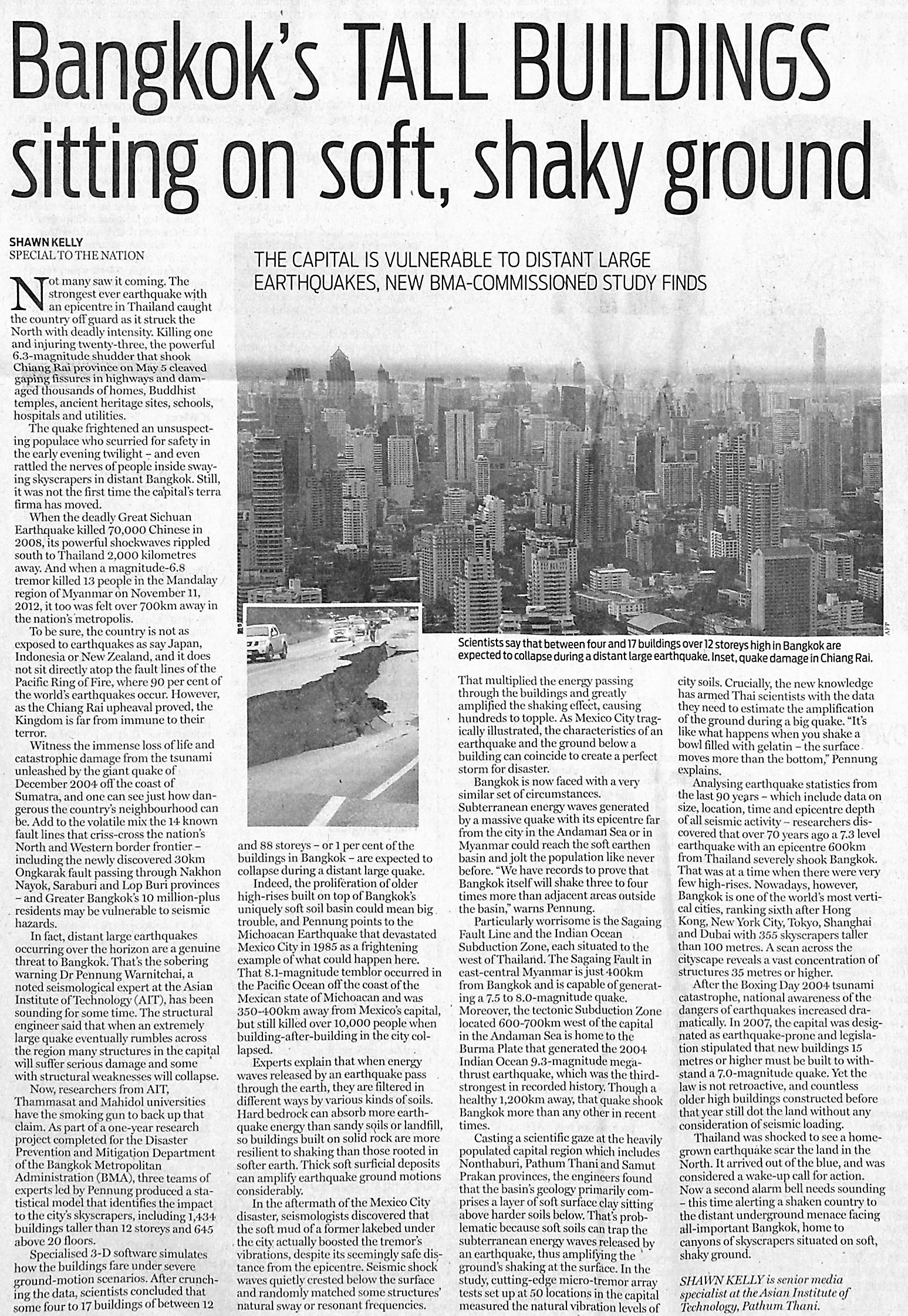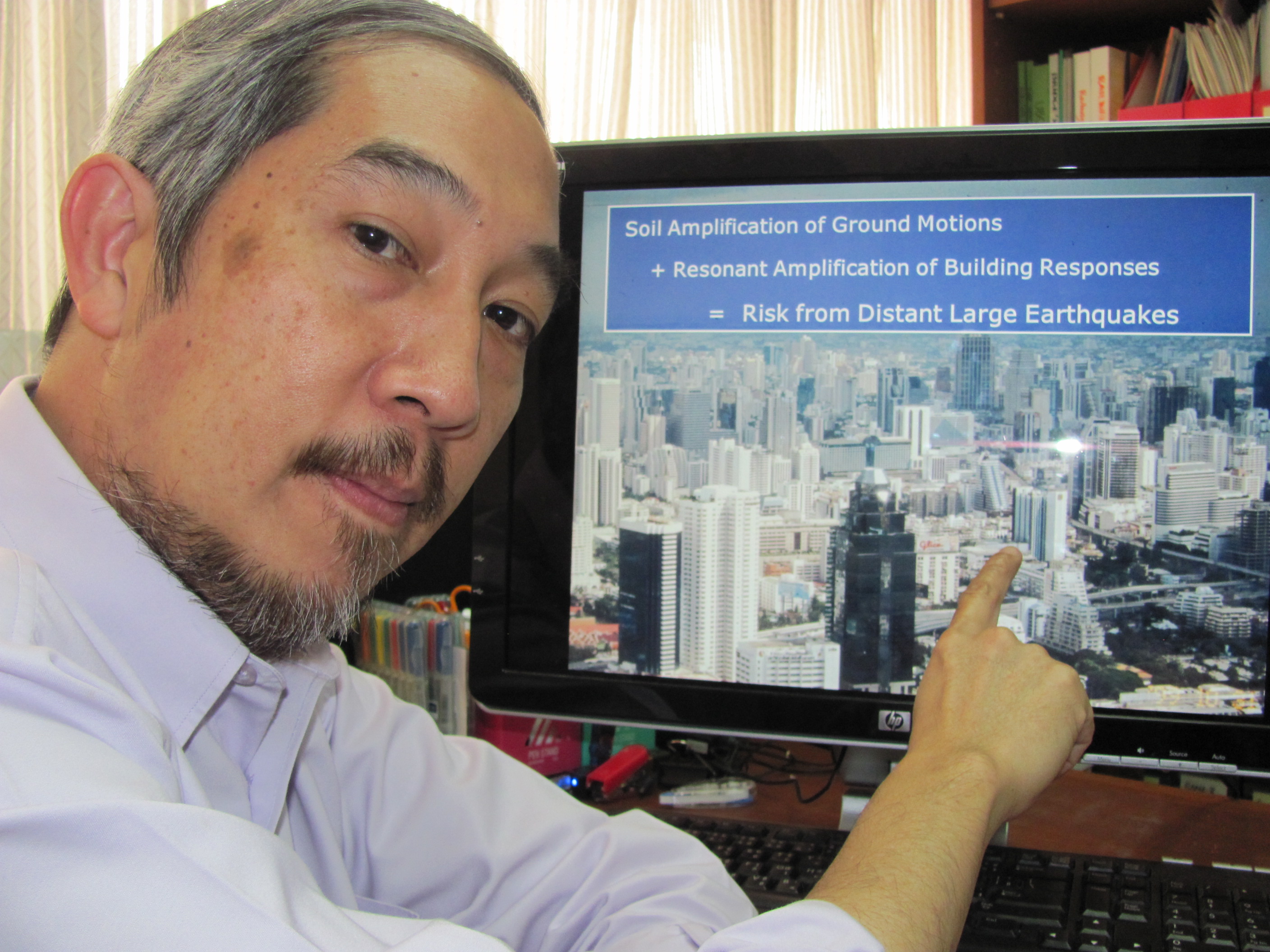(Published in The Nation, 21 May 2014)
Shawn Kelly
SPECIAL TO THE NATION
Not many saw it coming. The strongest ever earthquake with an epicentre
in Thailand caught the country off guard as it struck the North with
deadly intensity. Killing one and injuring twenty-three, the powerful
6.3-magnitude shudder that shook Chiang Rai province on May 5 cleaved
gaping fissures in highways and damaged thousands of homes, Buddhist
temples, ancient heritage sites, schools, hospitals and
utilities.
The quake frightened an unsuspecting populace who scurried for safety
in the early evening twilight - and even rattled the nerves of people
inside swaying skyscrapers in distant Bangkok. Still, it was not the
first time the capital's terra firma has moved.
When the deadly Great Sichuan Earthquake killed 70,000 Chinese in
2008, its powerful shockwaves rippled south to Thailand 2,000
kilometres away. And when a magnitude-6.8 tremor killed 13 people in
the Mandalay region of Myanmar on November 11, 2012, it too was felt
over 700km away in the nation's metropolis.
To be sure, the country is not as exposed to earthquakes as say Japan,
Indonesia or New Zealand, and it does not sit directly atop the fault
lines of the Pacific Ring of Fire, where 90 per cent of the world's
earthquakes occur. However, as the Chiang Rai upheaval proved, the
Kingdom is far from immune to their terror.
Witness the immense loss of life and catastrophic damage from the
tsunami unleashed by the giant quake of December 2004 off the coast of
Sumatra, and one can see just how dangerous the country's neighbourhood
can be. Add to the volatile mix the 14 known fault lines that
criss-cross the nation's North and Western border frontier - including
the newly discovered 30km Ongkarak fault passing through Nakhon Nayok,
Saraburi and Lop Buri provinces - and Greater Bangkok's 10 million-plus
residents may be vulnerable to seismic hazards.
In fact, distant large earthquakes occurring over the horizon are a
genuine threat to Bangkok. That's the sobering warning Dr Pennung
Warnitchai, a noted seismological expert at the Asian Institute of
Technology (AIT), has been sounding for some time. The structural
engineer said that when an extremely large quake eventually rumbles
across the region many structures in the capital will suffer serious
damage and some with structural weaknesses will collapse.
Now, researchers from AIT, Thammasat and Mahidol universities have the
smoking gun to back up that claim. As part of a one-year research
project completed for the Disaster Prevention and Mitigation Department
of the Bangkok Metropolitan Administration (BMA), three teams of
experts led by Pennung produced a statistical model that identifies the
impact to the city's skyscrapers, including 1,434 buildings taller than
12 storeys and 645 above 20 floors.
Specialised 3-D software simulates how the buildings fare under severe
ground-motion scenarios. After crunching the data, scientists concluded
that some four to 17 buildings of between 12 and 88 storeys - or 1 per
cent of the buildings in Bangkok - are expected to collapse during a
distant large quake.
Indeed, the proliferation of older high-rises built on top of
Bangkok's uniquely soft soil basin could mean big trouble, and Pennung
points to the Michoacan Earthquake that devastated Mexico City in 1985
as a frightening example of what could happen here. That 8.1-magnitude
temblor occurred in the Pacific Ocean off the coast of the Mexican
state of Michoacan and was 350-400km away from Mexico's capital, but
still killed over 10,000 people when building-after-building in the
city collapsed.
Experts explain that when energy waves released by an earthquake pass
through the earth, they are filtered in different ways by various kinds
of soils. Hard bedrock can absorb more earthquake energy than sandy
soils or landfill, so buildings built on solid rock are more resilient
to shaking than those rooted in softer earth. Thick soft surficial
deposits can amplify earthquake ground motions considerably.
In the aftermath of the Mexico City disaster, seismologists discovered
that the soft mud of a former lakebed under the city actually boosted
the tremor's vibrations, despite its seemingly safe distance from the
epicentre. Seismic shock waves quietly crested below the surface and
randomly matched some structures' natural sway or resonant frequencies.
That multiplied the energy passing through the buildings and greatly
amplified the shaking effect, causing hundreds to topple. As Mexico
City tragically illustrated, the characteristics of an earthquake and
the ground below a building can coincide to create a perfect storm for
disaster.
Bangkok is now faced with a very similar set of circumstances.
Subterranean energy waves generated by a massive quake with its
epicentre far from the city in the Andaman Sea or in Myanmar could
reach the soft earthen basin and jolt the population like never before.
"We have records to prove that Bangkok itself will shake three to four
times more than adjacent areas outside the basin," warns Pennung.
Particularly worrisome is the Sagaing Fault Line and the Indian Ocean
Subduction Zone, each situated to the west of Thailand. The Sagaing
Fault in east-central Myanmar is just 400km from Bangkok and is capable
of generating a 7.5 to 8.0-magnitude quake. Moreover, the tectonic
Subduction Zone located 600-700km west of the capital in the Andaman
Sea is home to the Burma Plate that generated the 2004 Indian Ocean
9.3-magnitude mega-thrust earthquake, which was the third-strongest in
recorded history. Though a healthy 1,200km away, that quake shook
Bangkok more than any other in recent times.
Casting a scientific gaze at the heavily populated capital region
which includes Nonthaburi, Pathum Thani and Samut Prakan provinces, the
engineers found that the basin's geology primarily comprises a layer of
soft surface clay sitting above harder soils below. That's problematic
because soft soils can trap the subterranean energy waves released by
an earthquake, thus amplifying the ground's shaking at the surface. In
the study, cutting-edge micro-tremor array tests set up at 50 locations
in the capital measured the natural vibration levels of city soils.
Crucially, the new knowledge has armed Thai scientists with the data
they need to estimate the amplification of the ground during a big
quake. "It's like what happens when you shake a bowl filled with
gelatin - the surface moves more than the bottom," Pennung
explains.
Analysing earthquake statistics from the last 90 years - which include
data on size, location, time and epicentre depth of all seismic
activity - researchers discovered that over 70 years ago a 7.3 level
earthquake with an epicentre 600km from Thailand severely shook
Bangkok. That was at a time when there were very few high-rises.
Nowadays, however, Bangkok is one of the world's most vertical cities,
ranking sixth after Hong Kong, New York City, Tokyo, Shanghai and Dubai
with 355 skyscrapers taller than 100 metres. A scan across the
cityscape reveals a vast concentration of structures 35 metres or
higher.
After the Boxing Day 2004 tsunami catastrophe, national awareness of
the dangers of earthquakes increased dramatically. In 2007, the capital
was designated as earthquake-prone and legislation stipulated that new
buildings 15 metres or higher must be built to withstand a
7.0-magnitude quake. Yet the law is not retroactive, and countless
older high buildings constructed before that year still dot the land
without any consideration of seismic loading.
Thailand was shocked to see a home-grown earthquake scar the land in
the North. It arrived out of the blue, and was considered a wake-up
call for action. Now a second alarm bell needs sounding - this time
alerting a shaken country to the distant underground menace facing
all-important Bangkok, home to canyons of skyscrapers situated on soft,
shaky ground.
(Shawn Kelly is senior media specialist at the Asian Institute of
Technology, Pathum Thani.)
The original article can be read at this link:
http://www.nationmultimedia.com/opinion/Bangkoks-tall-buildings-sitting-on-soft-shaky-grou-30234105.html


